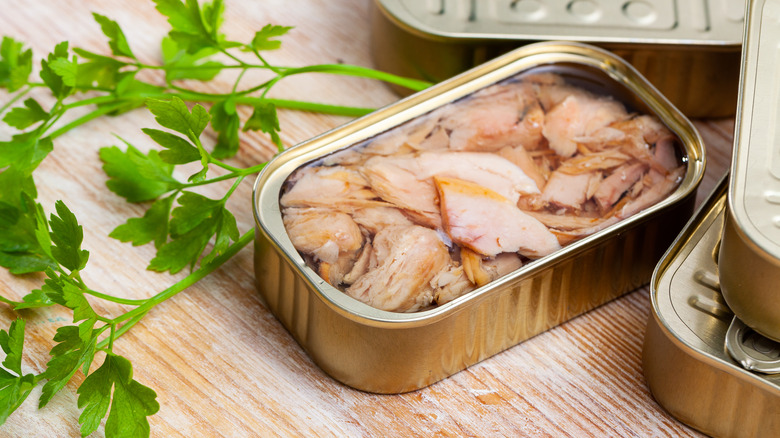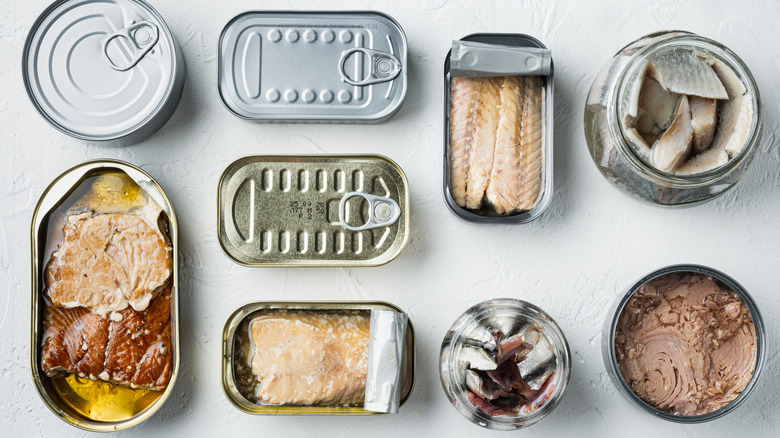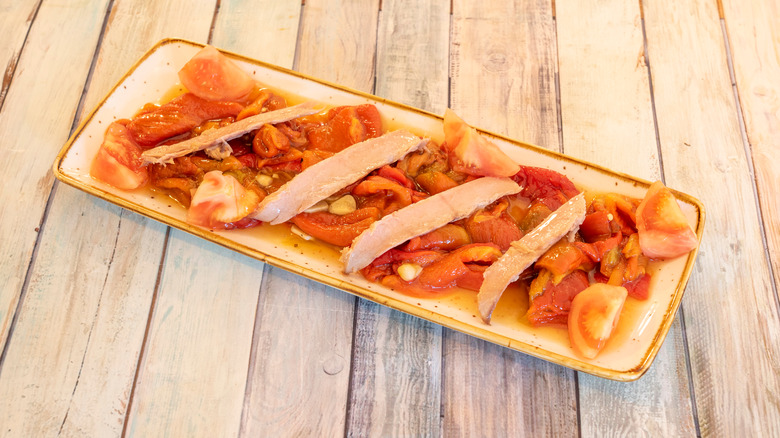Meet Ventresca, The Canned Tuna With Luxurious Buttery Flavor
Canned tuna often gets a bad rap, but the truth is there is a whole world of it beyond those mushy, oddly pink shards. The variety of canned tuna available has expanded and now includes numerous cuts and preparations, many of which are high quality and so delicious you can enjoy them straight from the can.
Unlike other common canned tunas — albacore, skipjack, bigeye, tongol, and yellowfin —ventresca refers to a cut of the fish, not a species of the tuna itself. Albacore tuna, also called "Bonito del Norte" in Spain and "Tombo" in Japan, is where ventresca comes from. Albacore tuna is mild in flavor with a pleasant saltiness, and ventresca consists of its marbled, delicate, and fatty belly filets. Ventresca, meaning belly in Italian, can be eaten fresh, but is commonly canned and preserved in oil. While the texture of albacore tuna filets is quite firm, the fat content in ventresca makes the texture softer and the taste buttery and rich.
How is ventresca made?
Ventresca falls into the category of high-quality preserved ingredients. In Spain, these canned or jarred products are called "conservas," and in Italy, "conservatas." White asparagus, piquillo peppers, olives, anchovies, mussels, octopus, and tuna belly are commonly found in conservas.
Ventresca is made by gently cooking, or poaching, the fatty tuna belly in oil, sometimes plain and sometimes with flavorings such as garlic, red pepper flakes, or lemon zest. Technically, you can poach ventresca in water, but canned tuna in water has a firmer feel. Ventresca is special because of the delicate texture that would be affected by water poaching, and preserving it in oil compliments the natural richness of the fish.
The oil-poached fish is then pressure canned in tins or glass jars. The ventresca actually improves over time, much like when you vacuum seal a protein in a marinade. It will last for several years on your pantry shelf. Once opened, ventresca can be kept in the fridge for up to five days.
How do you eat ventresca?
You can use ventresca anywhere you would use other canned tuna for a luxurious upgrade, like in salade niçoise. Ventresca is often served straight out of the tin alongside potato chips or crackers. Upgrade your grazing board with pickles, olives, and manchego cheese, and pair with a light and young red wine or a mineral-driven white. Another typical Spanish preparation is a tomato and ventresca salad, seasoned simply with salt, the oil from the tuna, and pickled shallots, served with crusty bread.
Try using ventresca to upgrade pasta alla puttanesca, which is full of complimentary flavors from tomatoes, capers, and olives. Blend ventresca with olive oil, capers, lemon juice, anchovies, and egg yolks to create a creamy tonnato sauce that you can use as a dip for grilled vegetables or as a fun Caesar salad riff.
Because this is an artisanal product, don't be afraid to let the tuna stand front and center. Add ingredients that complement the ventresca, but don't overload it. Ventresca shines on its own, offering a truly exquisite experience for your taste buds.



